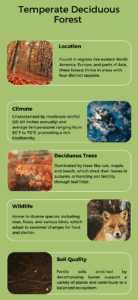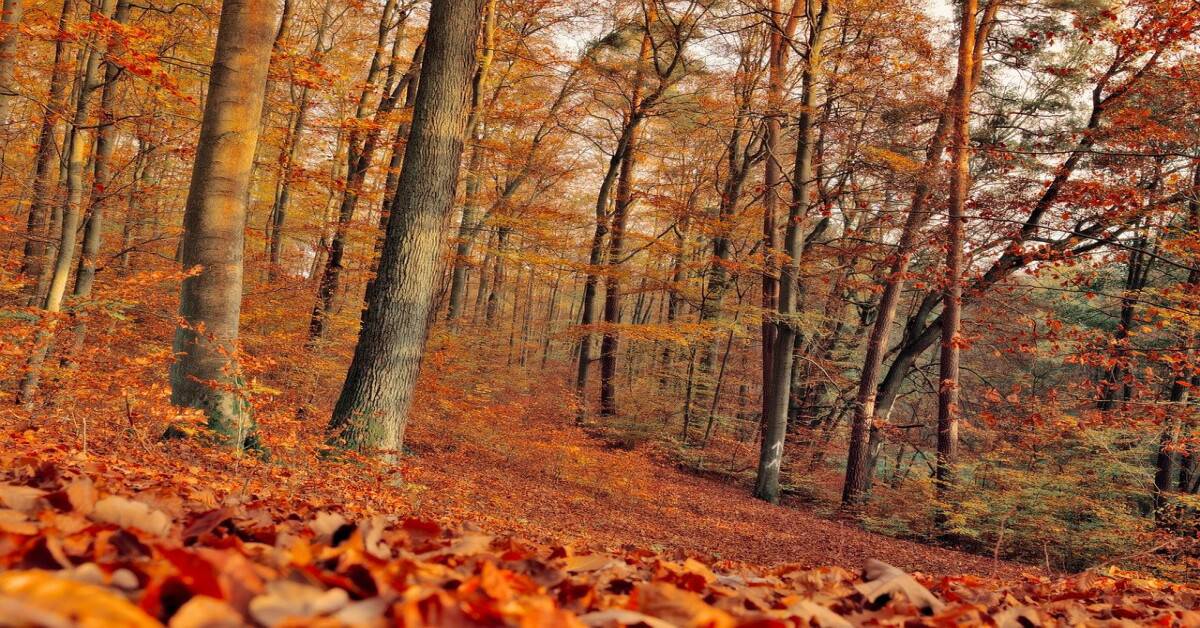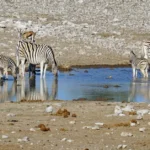Temperate deciduous forests are one of the most beautiful and diverse ecosystems on Earth. They are known for their rich variety of trees, plants, and wildlife that change with the seasons.
These forests are home to tall, leafy trees like oak, maple, and beech, which shed their leaves each autumn. The cycle of growth and decay keeps the ecosystem thriving.
These forests are not just found in one part of the world. They spread across North America, Europe, and Asia, offering a wide range of biodiversity. However, human activities are threatening their survival. Deforestation and climate change are putting pressure on these delicate ecosystems.
Therefore, understanding their importance is essential for protecting them. In this article, we will explore the features and distribution of temperate deciduous forests and why they matter for our planet.

What Makes a Temperate Deciduous Forest?
A temperate deciduous forest is a vibrant, ever-changing ecosystem. Its defining feature is the deciduous trees, which lose their leaves every fall. This shedding is a way for the trees to conserve water during cold winters.
In spring, they come back to life, creating a canopy of green. Oak, maple, and beech are common trees found in these forests.
Temperate deciduous forests experience four distinct seasons: winter, spring, summer, and fall. Each season brings noticeable changes to the environment.
Summers are warm, and winters are cold, but what makes these forests unique is the balance between the two. This balance allows a wide variety of plants and animals to thrive. The soil in these forests is also rich and fertile, perfect for supporting life.
Therefore, temperate deciduous forests play a crucial role in the environment. They act as homes for wildlife, help regulate the climate, and offer beauty that changes with each season.
Climate and Seasonal Changes
The climate in temperate deciduous forests is a major factor in shaping the ecosystem. These forests are located in regions that experience all four seasons. Winters are cold, while summers are warm and humid. The average yearly temperature ranges between 50°F and 70°F.
Rainfall is spread evenly throughout the year, providing just the right amount of moisture for plant growth. Snow is common during winter months in many temperate forests, giving the ecosystem time to rest.
The most fascinating aspect of these forests is how the seasonal changes affect both the plants and wildlife. In the spring, trees burst with new leaves, creating a dense canopy. By summer, the forest is lush and green.
In autumn, the leaves change color and fall to the ground, covering the forest floor in a blanket of red, orange, and yellow. Finally, in winter, the forest becomes bare as the trees conserve energy and prepare for the cold months ahead.
These seasonal shifts create a dynamic environment. Wildlife must adapt to these changes, too. For example, many animals store food or migrate during winter to survive. Therefore, the climate and seasonal shifts make temperate deciduous forests a constantly evolving landscape, rich in life and diversity.
Flora in Temperate Deciduous Forests
The plant life in temperate deciduous forests is as diverse as it is beautiful. These forests are dominated by deciduous trees like oak, maple, and beech. Each of these trees sheds its leaves in the fall to survive the cold winter months.
In spring, they grow fresh leaves, making the forest dense and full of life again. The trees can grow up to 100 feet tall, creating a canopy that shelters the plants and animals below.
Besides the towering trees, temperate deciduous forests also have a rich undergrowth. Shrubs, ferns, and wildflowers thrive in the shaded environment. These plants take advantage of the sunlight that filters through the canopy.
In the spring, when the trees are still bare, many plants bloom, taking full advantage of the light before the leaves return.
Furthermore, the plants in these forests are well adapted to the changing seasons. For example, wildflowers bloom early in spring to make the most of the sunlight before the trees’ leaves grow back.
The fallen leaves in autumn break down into rich, nutrient-filled soil, which feeds the plant life. Therefore, the flora of temperate deciduous forests is not only diverse but also deeply connected to the seasonal cycle.
Also Read: Mangrove Forest Structure and Features
Fauna: Wildlife of Temperate Deciduous Forests
Temperate deciduous forests are home to a wide variety of animals. These forests provide the perfect environment for wildlife to thrive, thanks to the changing seasons. Mammals like deer, foxes, and squirrels are common in these forests.
Birds, such as woodpeckers and owls, make their nests in the tall trees. Some animals are active year-round, while others hibernate or migrate during the colder months.
The seasonal changes influence how these animals live. For example, bears spend the fall eating as much as they can to prepare for winter hibernation. Squirrels gather and store food for the winter, while many birds fly to warmer regions.
In spring, these forests come alive again. Deer return to graze, and birds build new nests as the trees bloom.
Besides mammals and birds, temperate deciduous forests are also home to reptiles, amphibians, and insects. Frogs, salamanders, and snakes thrive in the moist environment, especially in the spring and summer. Insects like butterflies, bees, and ants are crucial to the forest’s ecosystem.
These animals play an important role in pollination, seed dispersal, and keeping the forest healthy. Therefore, the wildlife in temperate deciduous forests is not only diverse but also closely tied to the changing seasons, creating a dynamic, balanced ecosystem.
Soil and Ecosystem Features
The soil in temperate deciduous forests is rich and fertile, thanks to the yearly cycle of leaf shedding. When trees lose their leaves in autumn, they create a thick layer of leaf litter on the forest floor.
This leaf litter gradually decomposes, releasing essential nutrients back into the soil. As a result, the soil becomes a vital part of the nutrient recycling process, supporting a wide variety of plant life.
This constant cycle of decay and growth keeps the ecosystem balanced. The rich soil nourishes not only the trees but also smaller plants like ferns and shrubs, which thrive in the undergrowth.
Furthermore, the diverse plant life supports a healthy food chain, from insects to large mammals. The ecosystem’s balance depends on the interactions between soil, plants, and animals. Without healthy soil, the forest could not sustain the rich biodiversity it’s known for.
Therefore, the soil plays a crucial role in maintaining the overall health of temperate deciduous forests.
Global Distribution of Temperate Deciduous Forests
Temperate deciduous forests are found across several regions of the world. These forests thrive in areas with moderate rainfall and four distinct seasons. They are most commonly found in the eastern United States, Europe, and parts of Asia.
For example, in North America, they stretch from the Appalachian Mountains to the Great Lakes. In Europe, these forests cover large parts of France, Germany, and Poland.
Asia also has significant areas of temperate deciduous forests, especially in China, Japan, and Korea. In India, regions such as the northeastern states and parts of the Himalayas contain similar forest ecosystems, though they are often referred to as subtropical deciduous forests.
The geography of these regions, with their mild summers and cold winters, creates the perfect conditions for these forests to thrive.
The global distribution of temperate deciduous forests is influenced by both climate and geography. For example, these forests are found in regions with an average temperature of around 50°F to 70°F and receive about 30-60 inches of rainfall each year.
This balanced climate allows the trees to lose their leaves in winter and regrow them in spring. Therefore, temperate deciduous forests are unique to areas with specific climatic conditions, making them a vital part of the Earth’s ecological diversity.
Human Impact on Temperate Deciduous Forests
Human activities have significantly impacted temperate deciduous forests. Deforestation, urbanization, and climate change are some of the biggest threats. Forests are cleared to make way for cities, agriculture, and industrial activities.
This leads to habitat loss for countless species and disrupts the natural balance of the ecosystem. Furthermore, the removal of trees affects the soil, causing erosion and reducing the land’s ability to support life.
Climate change is another growing concern. Rising temperatures and changing rainfall patterns alter the seasons, affecting both plant and animal life in these forests.
For example, trees may not shed their leaves properly, or animals may struggle to find food. Therefore, the impact of human activities is pushing these forests to the brink.
Conservation efforts are critical to protecting these ecosystems. By understanding how human actions affect temperate deciduous forests, we can take steps to ensure their survival.
Conservation and Sustainability Efforts
Efforts to conserve temperate deciduous forests are becoming increasingly important. Reforestation is one of the key methods used to restore damaged areas. Planting new trees helps replenish the forest and provides habitats for wildlife.
Besides reforestation, sustainable management practices are being implemented. This includes controlled logging, where trees are carefully harvested to minimize environmental impact.
Globally, organizations and governments are working together to protect these forests. For example, the Forest Stewardship Council promotes responsible forest management.
On a local level, community-based conservation projects focus on preserving the natural beauty and biodiversity of these forests. Education and awareness campaigns also play a crucial role in encouraging people to take action.
Therefore, the combined efforts of reforestation, sustainable management, and global cooperation are vital in safeguarding the future of temperate deciduous forests. Without these initiatives, the survival of these delicate ecosystems would be at great risk.
Conclusion
Protecting temperate deciduous forests is vital for our planet. These forests are home to countless plants and animals, all playing a role in our ecosystem. They help maintain the balance of nature by purifying the air, regulating water cycles, and preventing soil erosion.
However, human activities are threatening their existence. Each tree lost means a home destroyed for wildlife and a step back for our environment.
By supporting conservation efforts, we can ensure these forests thrive for future generations. Every small action counts, whether it’s planting a tree or advocating for sustainable practices.
Therefore, understanding and appreciating the unique features and distribution of temperate deciduous forests can inspire us to take action. Together, we can protect these incredible ecosystems and the rich life they support.








